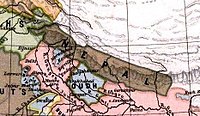
Back Горкха (дзяржава) Byelorussian गोरखा राज्य Bihari Königreich Gorkha German Reino Gorkha Spanish गोरखा राज्य Hindi Kerajaan Gorkha ID ゴルカ王国 Japanese गोरखा राज्य Nepali گورکھا سلطنت PNB Горкха Russian
Kingdom of Gorkha गोरखा राज्य (Nepali) | |||||||||
|---|---|---|---|---|---|---|---|---|---|
| 1559–1768 CE | |||||||||
Coat of Arms of Shah dynasty
| |||||||||
 The maximum extent of Gorkha Kingdom | |||||||||
| Capital | Gorkha Darbar | ||||||||
| Common languages | Khas (later Nepali) | ||||||||
| Religion | Hinduism | ||||||||
| Government | Monarchy | ||||||||
| Māhārājādhirāj (Sovereign King) | |||||||||
• 1559–1570 CE | Dravya Shah (first) | ||||||||
• 1570–1605 CE | Purna Shah | ||||||||
• 1609–1633 CE | Ram Shah | ||||||||
• 1633–1645 CE | Dambar Shah | ||||||||
• 1645–1661 CE | Krishna Shah | ||||||||
• 1661–1673 CE | Rudra Shah | ||||||||
• 1673–1716 CE | Prithvipati Shah | ||||||||
• 1716–1743 CE | Nara Bhupal Shah | ||||||||
• 1743–1768 CE | Prithvi Narayan Shah (last) | ||||||||
| History | |||||||||
• Established | 1559 | ||||||||
• Disestablished | 1768 CE | ||||||||
| |||||||||
| Today part of | Nepal | ||||||||
| History of Nepal |
|---|
 |
|
|
The Gorkha Kingdom (Nepali: गोरखा राज्य;Gōrakhā rājya) was a member of the Chaubisi rajya, a confederation of 24 states, located at the intersection of Himalayas and the Indian subcontinent. In 1743 CE, the kingdom began a campaign of military expansion, annexing several neighbors and becoming present-day Nepal.[1] The Gorkha Kingdom extended to the Marshyangdi River in the west, forming its border with the Kingdom of Lamjung. To the east, the kingdom extended to the Trishuli River, forming its border with the Nepal Mandala.[2] The Gorkha Kingdom was established in 1559 CE by Prince Dravya Shah, the second son of King Yasho Brahma Shah of Lamjung. The prince replaced the King Mansingh Khadka Magar who previously ruled the region.[citation needed]
- ^ Hamilton, Francis Buchanan (1819). An Account of the Kingdom Of Nepal and of the Territories Annexed to This Dominion by the House of Gorkha. Edinburgh: Longman. Archived from the original on 13 November 2012. Retrieved 12 January 2013. Page 237.
- ^ Kirkpatrick, Colonel (1811). An Account of the Kingdom of Nepaul. London: William Miller. Retrieved 12 January 2013. Page 123.

